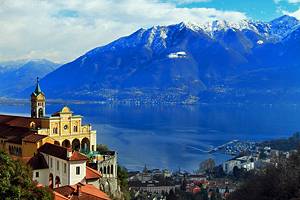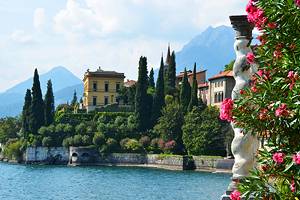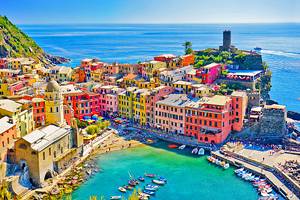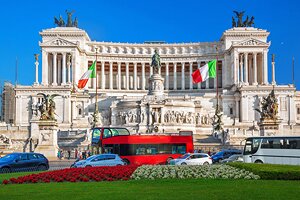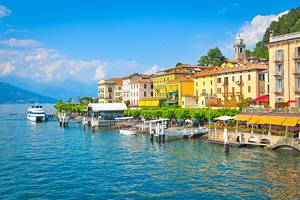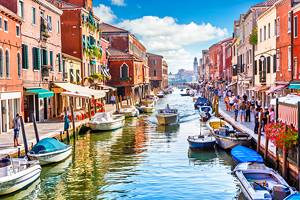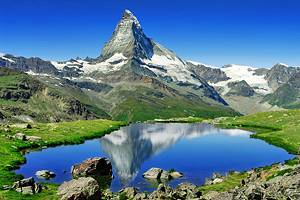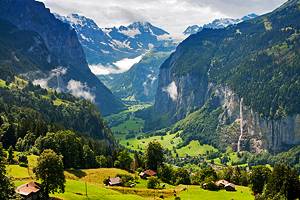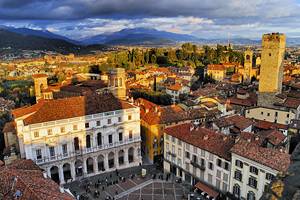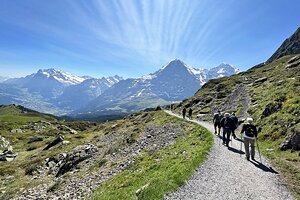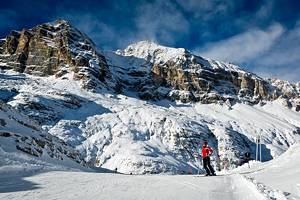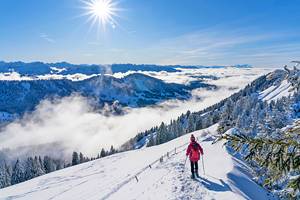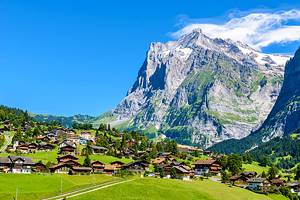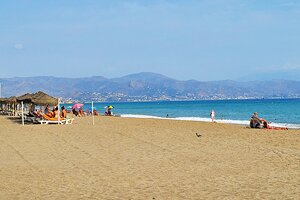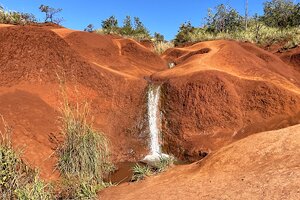14 Top Attractions & Things to Do at Lake Maggiore
Lying north of Milan, Lake Maggiore (Lago Maggiore) stretches for about 65 kilometers, reaching into the Ticino region of Switzerland. Despite its name ("maggiore" means "major"), it is only the second largest of northern Italy's lakes. Its most popular attractions are on the western shore, where the magnificent Borromean Islands, with their subtropical parks, draw the most tourists.

The trees of Lake Maggiore include a number of subtropical species: figs, olives, and pomegranates flourish in the mild climate, and several splendid show gardens are open to visitors. These gardens, boat excursions, and basking in the holiday ambience of lakeside towns are the most popular things to do on Lake Maggiore.
Regular boat services connect the various lake towns. But as several of the most popular attractions are not close to a boat stop, a car is the best way to explore the entire lake. A car ferry across the center of the lake makes this even easier. Another benefit of having a car here is the ease of taking a day trip to Lake Orta, a beautiful and little-known lake with an island you can visit by boat.
Plan your sightseeing in this beautiful area with our list of the top attractions and things to do around Lake Maggiore.
- Tour Isola Bella
- Visit Villa Taranto
- Take a Boat Trip on Lake Maggiore
- Isola Madre
- Eremo di Santa Caterina del Sasso (Hermitage of St Catherine) and Laveno
- Wander around Isola dei Pescatori
- Rocca d'Angera
- Stresa
- Villa Pallavicino
- Cannobio and Cannero Riviera
- San Carlone (San Carlo Borromeo Statue)
- Lake Orta
- Take a Boat to the Gardens of Isole di Brissago
- Visit Ascona
- Map of Attractions & Things to Do at Lake Maggiore
Tour Isola Bella

The Borromean Islands lie off Stresa, where boats leave regularly for all three islands, stopping first at Isola Bella, where between 1650 and 1671, Count Vitaliano Borromeo built up terraces and created a splendid summer palace. You can tour its magnificent state apartments, highlighted by the ornate Salone Grande; the domed Salone delle Feste; the Sala da Ballo (Ballroom); and the Sala della Musica, filled with rare musical instruments.
Below are six grottoes, artificial caves whose walls are encrusted with shells and pebbles. Sumptuous furnishings and collections of 17th-century Flemish tapestries and Lombard paintings of the 16th and 17th centuries decorate the palace.
But for most visitors, the most impressive part of Isola Bella is the Italian-style garden, rising in ten terraces to a height of 32 meters and covered with luxuriant southern vegetation. Rows of lemon and orange trees, cherry-laurels, tall cedars, magnolias, cork-oaks, sago-palms, carob-trees, camellias, and oleanders frame beautiful lake and mountain views, and parterres of brilliant flowers cover the ground supported by the stone terraces.
Visit Villa Taranto

One of Italy's most beautiful gardens, the lovely park of the Villa Taranto was created after the Second World War by a retired Scottish army officer, a botanist who collected plants from around the world to grow in this English landscape-style garden park.
More than 20,000 plant varieties — flowers, trees, shrubs, and water plants — native to this region and to places as distant as the Amazon rainforests thrive in this beautiful setting overlooking lake views, making Villa Taranto one of the most popular places to visit on Lake Maggiore.
Highlights of the gardens are the Dahlia Maze, with more than 1,700 plants in bloom, and the Paraguayan waterlilies, whose leaves can be nearly two meters in diameter. Another water feature is a pond filled with lotus, their leaves rising more than a meter above the water's surface.
Dedicated plant lovers should stop in the Herbarium in the charming porter's lodge, where dozens of cabinets display plants native to the British Isles.
Address: Via Vittorio Veneto, Verbania
Take a Boat Trip on Lake Maggiore

The best views of many of the attractions along the shore of Lake Maggiore are from the water, so you'll want to take at least one trip by boat. Steamers, hydrofoils (corse rapide), and car ferries (traghetti) connect the Italian shore towns frequently, operated by Navigazione Lago Maggiore.
Along with the regular service between towns, there are several excursions from late March through mid-October. These include one from Laveno to Verbania and the three Borromean Islands, returning to Laveno. This is a good way for tourists staying on the west side of the lake to combine a scenic cruise with visiting the three islands, without having to drive around the lake.
A cruise is also an easy way to visit the northern part of the lake, where Maggiore narrows scenically between steep mountainsides. The northernmost of Lake Maggiore's shore towns are in the Ticino, the Italian-speaking canton of Switzerland. Only three daily boats travel from the southern towns to northernmost Locarno, but more frequent boats leave from Luino, at the middle of Maggiore's eastern shore.
Isola Madre

Like Isola Bella, Isola Madre belongs to the Borromeo family. The island has beautiful English-style grounds surpassing even Isola Bella in the variety and luxuriance of their plants, although by the nature of a landscape garden, they are less dramatic and more designed for strolling and appreciating the lake views at leisure. They are especially beautiful in the spring and early summer when the azaleas, rhododendrons, and camellias are in bloom.
The villa is far less flamboyant than the palace on Isola Bella, and is particularly interesting for its collection of marionettes and stage scenery for puppet shows, as well as 17th-century paintings and porcelain.
Eremo di Santa Caterina del Sasso (Hermitage of St Catherine) and Laveno

The best views of the beautiful 13th-century hermitage and church dedicated to St. Catharine are as you approach from the lake. From this vantage, you can fully appreciate how the three buildings are carved into a narrow terrace in the steep cliff.
The hermitage was founded by a merchant who was shipwrecked in a storm and took refuge in a cave. In thanksgiving for being saved he vowed a hermitage to St. Catherine, and in 1195 built a tiny church. The oldest of the buildings you see today date from a century later, when it was home to Augustinian monks, and from the 14th and 15th centuries.
The 14th-century bell tower seems to rise straight out the lake. If you arrive by boat, prepare to climb the 80 steps to the hermitage, and be careful to take an early boat that allows you time to see it before the entire complex closes, from noon until 2pm. If you arrive by car, you can avoid the 240 steps down to the hermitage and back by riding an elevator (which also closes for midday).
The hermitage is south of Laveno, a town that's worth a stop to ride the Funivia, an unusual bucket gondola, to within 100 meters of the summit of 1,000-meter Sasso del Ferro. The two-person cars are open — you stand in a cosy bucket for the open-air ride; at the top is a terrace and café, along with breathtaking views of the lake and mountains.
Not far west of Laveno is the Villa della Porta Bozzolo, an aristocratic home dating from the 1500s. Along with its sumptuous interior and original furnishings, the villa is set against a hillside of terraced gardens, with fountains and frescoed out buildings.
Wander around Isola dei Pescatori

Unlike the other two Borromean Islands, Isola dei Pescatori has no grand palace, villa, or gardens. Instead, it is a simple fishing village of homes built along its highest point, their doorways facing inward along a narrow street so spring and autumn high lake waters won't flood them. About 50 year-round residents come and go by boat, and some families still make their living by fishing.
It's a pleasant and atmospheric place to wander, and its few restaurants specialize in lake fish. Be there for lunch or ask which of these provides free boat service from the mainland if you'd like to return in the evening to dine on the terrace by sunset.
Rocca d'Angera

Rocca d'Angera, the Borromeo castle overlooking the lake at Angera, is a medieval fortified stronghold whose structure has been preserved almost intact. The castle was originally built by the Visconti family, rulers of Milan from 1277 to 1447, and frescoes in the Sala della Giustizia show Ottone Visconti's victory over Napo Torriani in 1277.
Inside is one of Europe's best collections of dolls and children's toys, with 12 rooms displaying more than 1,000 dolls, toys, board games, and children's books. Dolls represent all periods of history and are made from every imaginable material, from wax to plastic. A beautiful medieval garden has been recreated from information in original manuscripts.
Address: Rocca d'Angera, Angera
Stresa

On the west side of Lake Maggiore, south of its western arm, the chic little town of Stresa looks onto the Borromean Islands. Stresa is the largest resort town on the Italian part of the lake and tends to cater to a moneyed crowd with its smart shops, upscale restaurants, and posh hotels.
The lakeside promenade, where much of tourist life centers, offers beautiful views across to the islands. If you're looking for the best places to go shopping in Stresa, look in the streets off Piazza Giocomo Matteotti, near the tourist information office.
Walkers looking for something more challenging than promenading along the lakeshore can hike the six-mile Chestnut Trail (Sentiero delle Castagne) through shady chestnut groves from Stresa to Belgirate. You can return to Stresa by bus or boat; download a trail map from the Visit Stresa website.
Villa Pallavicino

From its dramatic entrance view of cypress trees carved into a row of arches, Villa Pallavicino is filled with surprises.
A combination of botanical garden and zoo, the park is beautifully landscaped into a natural amphitheater surrounding a villa. Magnolia trees; sequoia; an impressive Lebanon cedar; and manicured lawns bordered by rhododendrons, camellias, and azaleas cover the grounds.
Greenhouses hold more exotic species. In the natural environment, animals appear to be roaming free, and you can encounter llamas, zebra, Tibetan goats, flamingos, swans, and colorful parrots — more than 40 different species — as you wander through the park. This variety of exotic animals makes this one of the most popular things to do for families with young children.
Address: Via Sempione 61, Stresa
Cannobio and Cannero Riviera

On the west shore of Lake Maggiore, almost to the Swiss border, Cannobio sits on a small plateau at the mouth of the Valle Cannobina. Its old town has picturesque narrow streets and a Palazzo della Ragione (town hall) built in 1291.
Near the landing-stage for lake excursion boats is the Santuario della Pietà, a Renaissance church that houses a small picture with a number of miracles attributed to it. On the high altar is a 16th-century painting, Christ Bearing the Cross, by Gaudenzio Ferrari.
Follow the valley, Valle Cannobina, to find the Orido Sant'Anna, a deep gorge that's spanned by a stone arch bridge. You can also walk there on a trail from Cannobio. A pretty chapel overlooks the bridge, and the pool below is a popular (if cold) spot for swimming.
Just south of Cannobio is one of the prettiest towns on Lake Maggiore, Cannero Riviera, sitting amid orchards and olive-groves. The climate here is the mildest on the lake, and lemon and orange trees can survive the winter outdoors. There is a beautiful beach, rare on the lake, and a pleasant promenade along the lakefront.
Just offshore, on rocky islets in the lake, are the ruins of the two Castelli di Cannero, castles built by Lodovico Borromeo in 1519 replacing earlier castles, which had been held by lake pirates. This is a quiet, peaceful choice for a base while exploring the lake, with a few small hotels, outdoor cafés, and great restaurants.
San Carlone (San Carlo Borromeo Statue)

Just north of Arona, near the village of Meina, a low hill is crowned by a 23-meter statue of St. Charles Borromeo (1538-84), Cardinal-Archbishop of Milan, who played an important part in the moral revival of Catholicism in northern Italy. He was born in Arona.
This gigantic statue, made of sheets of hammered copper bolted together, was erected between 1614 and 1698, shortly after the cardinal's canonization. One of the most unusual things to do on Lake Maggiore is to inspect the interior and look at the world through the eyes of a saint — literally — by climbing the stairway inside the statue. Up to six people can fit into its head alone.
Address: Piazzale San Carlo, Arona Novara
Lake Orta

On the west side of Monte Mottarone, little Lake Orta is overlooked by most tourists visiting the Italian lakes region, which only increases its appeal. The picture-perfect medieval town of Orta San Giulio tumbles down the steep wooded shore to Piazza Motta, where you can (and should) take a boat to the tiny island of Isola San Giulio in the lake's center.
Moss-covered stone buildings surround the island's 12th-century Basilica di San Giulio, built by the saint who, according to local legend, drove the snakes off the island. Be sure to see the frescoes and the beautifully carved marble pulpit, then follow the stone-paved Way of Silence between the island's old buildings.
On the forested hillside above Orta San Giulio is one of the nine Sacri Monti, mountainside sanctuaries unique to this region and that have been named a UNESCO World Heritage Site. This one is composed of 20 chapels holding terra-cotta statues that portray scenes from the life of St. Francis of Assisi.
Take a Boat to the Gardens of Isole di Brissago

Just north of the Italian-Swiss border off the western shore of Lake Maggiore, the two small islands of Brissago are easy to reach by a short boat ride from the village of Ronco. The larger island is covered in a botanical garden of 1,500 exotic plant species native to subtropical regions of Asia, South Africa, and the Americas.
Plants from these milder climates can thrive here because of the lake's moderating influence. The gardens were originally the work of Baroness Antonietta Saint Leger, who began planting her collection here is 1885. The work was continued in the 1920s, when the villa was built.
The guided sightseeing tour, included with entry, relates the history of the gardens and stories about the plants. If you're traveling with children, they will want to follow the free map on a treasure hunt for lost flowers. Stay for lunch on the terrace of the villa, overlooking the gardens and lake.
Visit Ascona

Once a modest fishing village, the Swiss town of Ascona, a little north of Ronco on Maggiore's western shore, is now a smart resort filled with high-end shops. Colorful buildings line the lakeside, overlooking the harbor filed with small craft.
Worth seeing are the 17th-century Casa Borrani with its elaborate Baroque facade, and the magnificent courtyard of the 16th-century Collegio Pontificio Papio.
On the hill high above the lake, you can visit the grounds and buildings of the Utopian community of Monte Verità, which thrived here in the early 20th century. The community attracted residents as diverse as artist Paul Klee, author DH Lawrence, and Nobel Prize-winning poet/novelist Hermann Hesse; a museum tells its story.
Along with the Jugendstil (Swiss Art Nouveau) villa and the Bauhaus-style hotel designed by Mies van der Rohe, Monte Verità's prime attraction is the 1939 Elisarion Pavilion, a rotunda built to house the cyclorama The Clear World of the Blissful, painted between 1919 and 1929.
Map of Attractions & Things to Do at Lake Maggiore
More Related Articles on PlanetWare.com
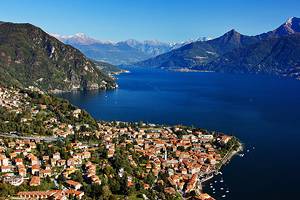
Places to Visit near Lake Maggiore: The splendid gardens at Isola Bella and Villa Taranto may whet your appetite for more beautiful gardens overlooking lake and mountain views. If so, the gardens and villas of Lake Como are not far away. The northern part of Lake Maggiore extends into the Italian-speaking canton of Switzerland, and our article on the Top Tourist Attractions in Lugano, Locarno, and the Ticino Region will give you ideas of what to see and do here.
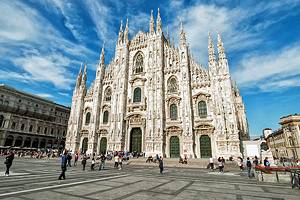
Exploring Milan and its Surroundings: The economic and commercial capital of Italy is just south of Lake Maggiore, and you'll find several PlanetWare articles helpful if you plan to visit Milan and its tourist attractions. Top Day Trips from Milan suggests other places you can travel from a base in the city.




